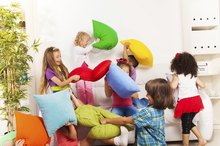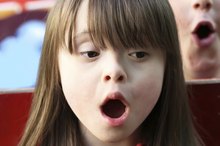Zumba Exercises for Preschool Children
Who says only adults like to get their groove on? Zumba, the spicy workout that's based around Latin music, now offers certifications to teach classes to children between the ages of 3 to 12. Although a license is required to teach an official fitness classes to children, you don't need a certificate to teach your preschooler some Zumba exercises at home 2. You need about 30 minutes, a little bit of Latin dance knowledge, a lot of patience, energy to burn and a love for Zumba 2.
The National Association for Sport and Physical Education suggests preschoolers have 60 minutes per day of structured physical activity. Learning Zumba routines is a fun way for preschoolers to work toward this goal. Structured dance classes like Zumba help kids with physical development, emotional maturity, cognitive growth and social awareness, according to National Dance Education Organization.
Class Structure
Children between the ages of 3 to 5 typically have short attention spans and lots of energy, but few dance skills. Fortunately, Zumba does not require any previous dance experience.
Keep the tone light since Zumba should feel more like a party than a lesson. Teach the preschooler one song at a time, going over steps until she's comfortable and can remember most of the movements. Have a few songs ready and let her pick the music she likes best.
Start your lesson stretching to slower Latin music while you discuss the dance you want to share. Estimate 30 minutes of dancing with a few water breaks before she loses interest.
- Children between the ages of 3 to 5 typically have short attention spans and lots of energy, but few dance skills.
- Estimate 30 minutes of dancing with a few water breaks before she loses interest.
Choreography Options
Galloping Activities for Children
Learn More
Keep choreography simple for kids, and slow down steps to include pauses where you can remind him what's coming next. Use the four Zumba basics: meringue, cumbia, salsa and raggeaton dance moves; incorporate kid-friendly exercises like big jumps, jumping jacks and karate chops.
Use musical queues to remind your dancer when the movement will change. Incorporate animal movements or familiar characters like zombies to engage his imagination while he's dancing. If you notice a movement is too difficult, change it.
- Keep choreography simple for kids, and slow down steps to include pauses where you can remind him what's coming next.
- Use musical queues to remind your dancer when the movement will change.
Sample Choregraphy
Try out an easy routine for the kids, starting with a meringue, one of the four basic Zumba rhythms.
- Start by marching during the beginning of the song.
- Add swinging hips and then simple arm movements by putting both arms straight out to the side and bending one arm in at a time. If the music has any pauses, use them to stop for two beats, then jump straight up.
- Land while making a "funny face" and turn to the right.
- Repeat the sequence facing the right-side of the room, then turn right again.
- Repeat until you are facing the front of the room again. March with arm movements until the song ends.
- Try out an easy routine for the kids, starting with a meringue, one of the four basic Zumba rhythms.
- Repeat the sequence facing the right-side of the room, then turn right again.
5.
Make It Fun!
Hand Clapping Games for Toddlers
Learn More
Make your lesson time fun by giving lots of positive feedback and keeping the atmosphere more playful than strict. If your preschooler's attention is fading, take a break. Kids like to copy your behavior at this age; if you're having fun, she will be, too — that's what Zumba is all about 2.
Read more: Fun Workouts for Kids
- Make your lesson time fun by giving lots of positive feedback and keeping the atmosphere more playful than strict.
Related Articles
References
- Kids Health: Fitness and Your 4- to 5- Year Old
- Zumba.com: About
- Dance Advantage: "12 Tips of Teaching Tots"; Nichelle Strzepek; January 2009
- Vendramin B, Bergamin M, Gobbo S, et al. Health benefits of Zumba fitness training: A systematic review. PM R. 2016;8(12):1181-1200. doi:10.1016/j.pmrj.2016.06.010
- Araneta MR, Tanori D. Benefits of Zumba Fitness® among sedentary adults with components of the metabolic syndrome: A pilot study. Journal of Sports Medicine and Physical Fitness. 2014;55(10):1227-1233.
- Inouye J, Nichols A, Maskarinec G, Tseng CW. A survey of musculoskeletal injuries associated with Zumba. Hawaii J Med Public Health. 2013;72(12):433-6.
- Delextrat AA, Warner S, Graham S, Neupert E. An 8-week exercise intervention based on Zumba improves aerobic fitness and psychological well-being in healthy women. J Phys Act Health. 2016;13(2):131-9. doi:10.1123/jpah.2014-0535
Writer Bio
Writing since 1978, Allison Stevens was writer and publisher of the Calvary Christian Fellowship newsletter and has had work appear in various online publications. Stevens has certification to teach group fitness and is a licensed Zumba instructor, teaching fitness classes for adults and children daily. She enjoys researching various subjects including health, and holds an Associate of Arts.









